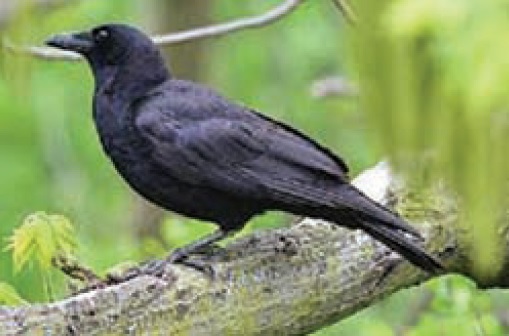It’s just not normal around here without the walk-about and hopping of crows in our yard. With their large size, black plumage, and constant chatting ¨caw¨, I find them very entertaining. As a wildlife enthusiast, I like to think that we are fortunate to have a family of 6 crows living in our trees for several years. And it’s fun to watch them fight over peanuts, dive-bomb my cats, chase off hawks, and leave me little gifts! This summer a crow, I like to call her ¨Gabby¨ spent a few months in one of our oak trees. All day she would perch on a branch and ever so quietly ¨caw” sounding more like an ¨aw.¨ It got to the point that my husband asked, ¨Is there something wrong with that crow?¨ Soon after, another crow perched nearby mimicking her call. She would respond with what sounded like ¨uh´-uh¨ as if to say, ¨Nope, you don’t float my boat¨ and off he would fly!

Now Gabby is an American Crow from the family Corvidae which also includes ravens, magpies, and jays. Don’t confuse a crow with a raven for the raven is larger and found in our mountains. Our crows are a common sight in treetops, fields, roadsides, neighborhood yards, and in their habitats ranging from open woods, beaches to town centers. In spring and summer, their nesting time, crows are usually seen in family groups of 2 to 8. But during late summer, fall and winter, their roosting time, crows gather from many miles away to form communal night roosts.
American Crows are social birds more often seen in groups than alone. Family life is important to crows and they live with multiple generations that work, learn, and feed together. The offspring help build the nests for their parents in tall trees using sticks and twigs; they help feed the nesting mother; and help protect the family from predators…owls being one of the worst. They are among the most intelligent birds in the world. Crows are said to count to a point, capable of using simple tools, playing tricks, teaching each other new things, device solutions to problems, recognize people and even hold grudges. They work together to harass and drive off predators like hawks, a behavior known as mobbing. Another interesting behavior is called ´anting´ where they stand on an anthill and let the ants discharge formic acid. This helps the crow rid their bodies of parasites and renders the ants quite palatable!
The crow’s biggest enemy is the West Nile Virus that was accidentally introduced to North America in 1999 causing encephalitis in humans and livestock and is especially deadly to crows. Virtually all crows that contract it die within one week. Note they do NOT transmit this disease to humans or other animals.
History shows that crows and ravens have suffered under the reputation of being ´bad´. It probably doesn´t help matters that a flock of crows is called a ´murder´. They raid farmers’ crops and frequently steal eggs and chicks from other bird’s nests. But in spite of that, they are beneficial and can eat 40,000 grubs, caterpillars, armyworms, and other insects in one nesting season. They also transport and store seeds, thus contributing to our forest renewal. Thanks to their resourcefulness and intelligence, I believe the American Crow is deserving of our respect and even admiration.
So, recently, I had to say goodbye to Gabby. I know she is searching for a nearby winter roost that sometimes numbers in the hundreds of thousands of crows. There she will find warmth, protection, social opportunities, a chance to share knowledge about food sources, and maybe, her life-long mate. Long may Gabby ¨caw!¨■

